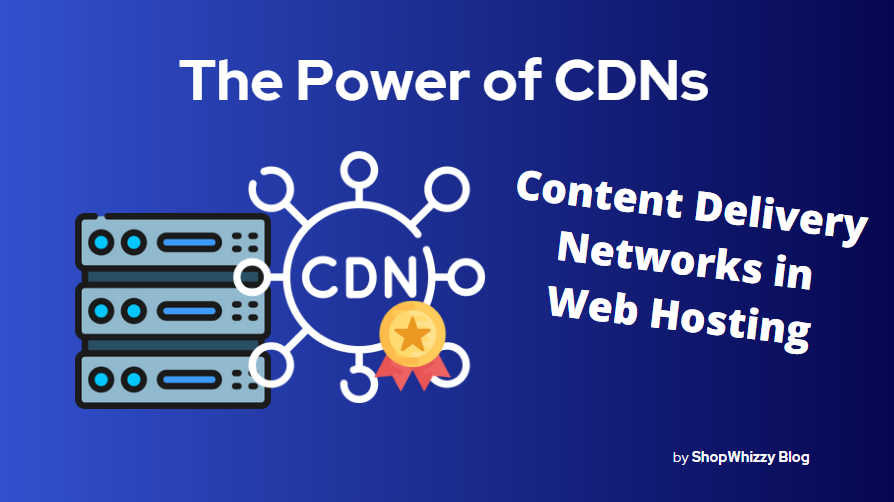Introduction
In the intricate web of online infrastructure, where speed, security, and scalability reign supreme, Content Delivery Networks (CDNs) emerge as the unsung heroes of web hosting. Their intricate network architecture and strategic deployment revolutionize the delivery of digital content, shaping user experiences and bolstering website performance. This comprehensive exploration embarks on a journey into the transformative potential of CDNs within the realm of web hosting, shedding light on their multifaceted capabilities and their profound impact on the digital landscape. Join us as we unravel the intricate workings and far-reaching implications of CDNs, unveiling their power to redefine the very essence of online presence and engagement.
Here are some topics for today:
-
Website Speed Optimization: CDNs strategically position servers globally to reduce latency, accelerating page load times through techniques like content caching and optimized routing.
-
Website Security Enhancement: CDNs implement robust security measures such as DDoS mitigation and SSL encryption, safeguarding web assets against cyber threats and ensuring data integrity.
-
Scalability: CDNs offer elastic scalability, dynamically distributing traffic to accommodate fluctuations in demand without compromising performance or uptime.
-
Global Reach and Accessibility: By deploying edge servers in key regions worldwide, CDNs ensure fast and reliable access to web content, enhancing global reach and accessibility for users across diverse geographic locations.
Accelerating Website Speeds
Content Delivery Networks (CDNs) represent a groundbreaking advancement in the quest for faster and more responsive websites, ushering in a transformative era in web hosting. At the heart of their effectiveness lies their strategic deployment of servers across the globe, which serves as the cornerstone of their ability to dramatically reduce latency and expedite page load times. This achievement is made possible through a sophisticated blend of techniques, including content caching, data compression, and optimized routing.
Content caching stands as a fundamental pillar of CDN functionality. This mechanism involves storing frequently accessed website content on servers located closer to end-users. By doing so, CDNs eliminate the need for data to traverse long distances, thereby minimizing latency and expediting content delivery. Additionally, CDNs leverage advanced data compression algorithms to condense file sizes without sacrificing quality, further enhancing the efficiency of content transmission and ensuring swift access to web resources.
In conjunction with content caching, optimized routing algorithms play a pivotal role in facilitating seamless data delivery within CDNs. These algorithms dynamically assess network conditions and select the most expedient routes for data transmission. By navigating around congestion and bottlenecks, CDNs ensure uninterrupted browsing experiences for users. This agile routing strategy optimizes resource utilization and enhances the overall responsiveness of websites hosted on CDN platforms.
In essence, CDNs serve as catalysts for website performance optimization, revolutionizing loading times and elevating user experiences to unprecedented levels of speed and efficiency. By harnessing the power of distributed networks and innovative technologies, CDNs empower web hosting providers to deliver content with unparalleled agility, ultimately enhancing user satisfaction and engagement in the digital realm. As the demand for faster, more responsive websites continues to escalate, CDNs will undoubtedly remain at the forefront of web hosting innovation, shaping the digital landscape for years to come.
Improving Scalability
The digital landscape is inherently volatile, with website traffic fluctuating unpredictably in response to various factors such as marketing campaigns, seasonal trends, or viral content. In such dynamic environments, traditional hosting infrastructures often struggle to accommodate sudden spikes in demand, leading to performance degradation and potential downtime. CDNs offer a scalable solution to this challenge, enabling web hosting providers to seamlessly handle fluctuations in traffic with ease.
At the core of CDN scalability lies its distributed network architecture. By dispersing content across a multitude of servers located in different geographic regions, CDNs distribute the load evenly, preventing any single server from becoming overwhelmed during periods of high traffic. Moreover, CDNs employ intelligent traffic management algorithms to dynamically route incoming requests to the most available and responsive servers, further optimizing resource utilization and ensuring optimal performance.
This elastic scalability not only enhances the reliability and availability of websites but also facilitates seamless scalability without the need for extensive infrastructure investments. Whether faced with sudden traffic spikes or sustained periods of increased demand, CDNs empower web hosting providers to scale their resources effortlessly, maintaining consistent performance and user satisfaction.
In summary, CDNs redefine the scalability paradigm in web hosting, offering a flexible and efficient solution to the challenges posed by fluctuating traffic patterns. By leveraging the inherent advantages of distributed networks and intelligent traffic management, CDNs enable web hosting providers to adapt and thrive in dynamic digital environments.
Bolstering Security Measures
In an era defined by relentless cyber threats and increasingly sophisticated attacks, safeguarding web assets against malicious actors is paramount. CDNs play a pivotal role in fortifying the security posture of websites and implementing a comprehensive array of measures to mitigate risks and protect sensitive data.
Distributed Denial of Service (DDoS) attacks pose a significant threat to website availability, inundating servers with malicious traffic and rendering them inaccessible to legitimate users. CDNs act as a frontline defense against DDoS attacks, leveraging their distributed infrastructure to absorb and mitigate malicious traffic before it reaches the origin server. Through intelligent traffic analysis and rate-limiting techniques, CDNs identify and neutralize DDoS attacks in real time, ensuring uninterrupted access to web resources.
Web Application Firewall (WAF) protection represents another critical component of CDN security. By inspecting incoming web traffic and filtering out malicious requests, WAFs prevent common attack vectors such as SQL injection, cross-site scripting (XSS), and other malicious exploits. Additionally, CDNs implement Secure Sockets Layer (SSL) encryption to encrypt data in transit, safeguarding sensitive information from eavesdroppers and unauthorized access.
Bot management is another essential feature of CDN security, enabling web hosting providers to distinguish between legitimate users and malicious bots. By implementing sophisticated bot detection algorithms and behavior analysis techniques, CDNs identify and mitigate bot-driven attacks, preserving the integrity of web resources and ensuring fair access for genuine users.
In summary, CDNs serve as stalwart guardians of web security, leveraging their distributed infrastructure and advanced security measures to protect against a wide range of cyber threats. By fortifying the perimeter of web hosting environments and safeguarding sensitive data, CDNs instill confidence and trust among users, fostering a secure and resilient online ecosystem.
Enhancing Global Reach and Accessibility
In our increasingly interconnected world, catering to diverse audiences spread across different geographic regions poses a significant challenge for web hosting providers. However, Content Delivery Networks (CDNs) step up to the plate, effectively bridging geographical gaps and amplifying global reach through their distributed network architecture.
CDNs strategically position edge servers in pivotal locations around the globe. This strategic deployment brings content physically closer to end-users, thereby minimizing latency and vastly improving accessibility. The decentralization inherent in this approach ensures that users, regardless of their geographical location, benefit from fast and reliable access to web content. As a result, browsing experiences become seamless, and user satisfaction is greatly enhanced.
Moreover, CDNs go beyond mere proximity by optimizing content delivery based on users' geographic locations. By dynamically selecting the most efficient route to transmit data, CDNs ensure that content reaches its destination via the fastest and most reliable path possible. Through real-time analysis of network conditions and proximity to edge servers, CDNs continuously fine-tune content delivery, further enhancing performance and elevating user experience to new heights.
The advantages of CDNs extend beyond improved performance to include enhanced reliability and resilience. By dispersing content across a diverse network of servers, CDNs effectively mitigate the risk of single points of failure. Additionally, they minimize the impact of localized outages or network disruptions by providing redundancy across their infrastructure. This redundancy ensures uninterrupted access to web resources, even in the face of unforeseen challenges or adverse conditions, thereby reinforcing user trust and confidence in the reliability of the hosted content.
In essence, CDNs not only revolutionize content delivery but also redefine the very fabric of global accessibility in web hosting. Through their strategic deployment, optimization strategies, and robust infrastructure, CDNs empower web hosting providers to transcend geographical limitations and deliver content with unparalleled speed, reliability, and resilience to users worldwide.
Conclusion
In summary, Content Delivery Networks (CDNs) epitomize a paradigm shift in the realm of web hosting, transcending geographical barriers and redefining the very essence of global reach and accessibility. Through their distributed network architecture and sophisticated optimization mechanisms, CDNs empower web hosting providers to transcend physical boundaries and deliver content to users worldwide with unprecedented levels of speed, reliability, and efficiency.
By strategically situating edge servers in key regions across the globe, CDNs bridge geographical divides and bring content closer to end-users, minimizing latency and optimizing content delivery. This strategic deployment ensures that users, regardless of their geographic location, experience fast and consistent access to web content, thereby enhancing user experience and fostering engagement.
Moreover, CDNs not only expedite content delivery but also bolster the reliability and resilience of web hosting environments. By dispersing content across a diverse network of servers, CDNs mitigate the risk of single points of failure and minimize the impact of localized outages or network disruptions. This redundancy ensures uninterrupted access to web resources, fostering trust and confidence among users.
Furthermore, CDNs facilitate the seamless exchange of information in an increasingly interconnected digital landscape. By optimizing content delivery and dynamically routing traffic, CDNs enable web hosting providers to adapt to evolving user demands and deliver content with unparalleled efficiency. This seamless exchange of information fosters collaboration, facilitates knowledge dissemination, and drives innovation across various sectors and industries.
In essence, CDNs redefine the boundaries of global reach and accessibility in web hosting, empowering web hosting providers to transcend geographical limitations and deliver content to users worldwide with unparalleled speed, reliability, and efficiency. By bridging geographical divides, optimizing content delivery, and fostering seamless exchange of information, CDNs pave the way for enhanced user experiences, increased engagement, and accelerated digital transformation in an interconnected world.


